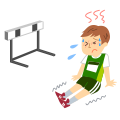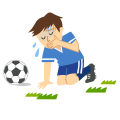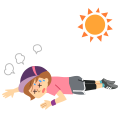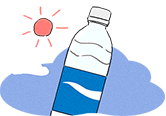Types of heat disorders
Heat disorders is a general term for several kinds of heat-related illnesses that occur due to environmental heat exposure.
Blood pressure decreases due to the dilation of the blood vessels in the skin, resulting in decreased flow of blood to the brain. The person's pulse quickens, and weakens.

Characteristics
- Dizziness
- Fainting
- Facial pallor
- Quickening and weakening of the pulse
Cramps accompanied by pain in the legs, arms, and abdomen occur when the concentration of salt (sodium) in the blood decreases due to heavy sweating, with fluid replaced by water only.

Characteristics
- Muscle pain
- Cramps
- Muscle convulsions
A person suffering heat exhaustion will sweat profusely. If rehydration is inadequate, the person will become dehydrated, and exhibit symptoms of heat exhaustion.

Characteristics
- General feeling of malaise
- Nausea/vomiting
- Headache
- Decreased ability to concentrate or make decisions
Heat stroke is a condition in which core bodily functions are impaired due to an excessively high body temperature. Heat stroke may result in impairment of consciousness (slow reactions, unusual speech and behavior, loss of consciousness), and going in to a state of shock.

Characteristics
- High body temperature
- Disturbance of consciousness
- Slow reaction to calls and stimuli
- Unusual speech and behavior
- Wobbly
Case studies highlighting situations in which extra attention should be paid and action taken to prevent
heat disorders, such as during sports activities and in the workplace.






